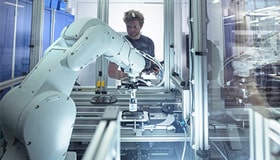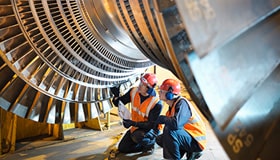A guide to vibration analysis
What is vibration analysis?
Vibration analysis collects and processes data about mechanical vibrations in a machine, component, or structure. It is used to detect abnormal vibrations that can indicate the overall condition of the object being tested. Many vibration analysis tools and techniques have been designed to measure, store, and extract vibration information. These techniques allow for condition monitoring of machines and can help a company improve its productivity, reduce its costs, and produce goods in a more sustainable way.
Why measure vibration?
Measuring vibration offers a number of advantages to engineers tasked with monitoring the health of structures and components. It can allow engineers to react in real-time to changes in the component’s condition and enables remote condition monitoring. There are also well-established vibration analysis techniques that can be used in predictive maintenance.
The two main applications of vibration monitoring are to protect the structural integrity of infrastructure such as bridges and pipelines and thus ensure they are safe to use, and to monitor components such as motors and bearings to prolong operation and manage their lifecycles and maintenance.
- Vibrations in motors and other moving parts
- Ensuring structural integrity
Vibrations can also occur due to motors and other moving components. It is normal for motors to generate small vibrations, however, changes or increases in motor vibration can indicate problems. There are several potential causes of motor vibration, including imbalances due to component defects, misaligned gears, bearing malfunctions, general wear and tear on bearings and other parts, or a motor that is loosely attached to its mounting.
Vibrations could indicate problems that reduce the energy efficiency of the motor, increasing costs. As energy prices rise this is a growing concern. However, the greatest costs can arise when a motor fails. As well as replacement or repair costs, this can interrupt production, losing revenue and causing further costs through the need to replace spoiled materials.
Another use of vibration analysis is to monitor the structural integrity of infrastructure items such as bridges, pipes and wind turbines. For example, as wind turbines become larger, they become subject to higher structural vibrations. Measuring the ‘normal’ vibrations of a wind turbine blade and then comparing them to observed changes in this pattern can indicate a structural problem, allowing the problem to be addressed before it causes a catastrophic failure.
Component failure can also occur rapidly, due to vibrations induced by the application of a shock load, which is a transient load that exhibits a very high amplitude over a short duration. Electronics equipment, for example, may be shipped with sensors to detect excessive shock and vibration.
How is vibration measured?
Vibration sensors are devices that measure the strength and frequency of a vibration in a particular component or system. The frequency of the vibration shows how often the vibration occurs. Tracking spikes in vibrations can help find the root cause of the issue. Vibration sensors also record the intensity of the vibration – the more vibration the equipment exhibits, the greater the intensity of the measurements.
There are several different types of vibration sensors, each working on different principles and having its own application. Some require direct contact with the component under test, while others can sense vibrations remotely. The most common type of vibration sensors are accelerometers, with strain gauges and microphone sensors also being widely used.
- Accelerometers
- Strain gauges
- Microphone sensors
Accelerometers measure the changes in velocity of the component. Vibrations indicate a change in velocity, changes that cause the accelerometer to produce an electrical signal. These signals can be processed to produce useable vibration data. Piezoelectric accelerometers are the most widely used type. They are popular because they produce a strong, clear signal at most frequencies, although piezoresistive accelerometers are also becoming increasingly common. These are adept at detecting high and low frequencies, though are significantly more expensive than the piezoelectric type.
Another contact method is strain gauges, which take the form of a foil applied directly to the component. The foil contains an electrically conductive grid, which deforms as the component experiences vibrations. These deformations change the electric resistance of the grid and by reading the time taken for an electric current to pass through it, the vibration of the object can be assessed.
To work, strain gauges need to be properly bonded to the surface of the component, which can make installing them a lengthy process.
Microphone sensors are also popular. Vibrations create sound which is often beyond the range of human hearing. Microphone sensors can detect changes in these high frequency sounds and are a cost-effective method of providing some basic information. They are often used alongside accelerometers.
There is a huge range of vibration sensors that are available to meet the requirements of almost any application.
What are the main vibration analysis techniques?
Once the data has been acquired by sensors it needs to be processed to detect issues. Vibration analysis techniques are based on three main methods - maximum acceleration, frequency analysis and artificial intelligence. Maximum acceleration looks at the amount of movement of the vibrating object, frequency analysis examines the rate at which these movements occur, and AI uses data to spot patterns that might indicate faults.
- Maximum acceleration
- Frequency analysis
- Artificial Intelligence
Maximum acceleration looks at vibration in the time domain. It plots the amplitude of the vibration from the highest point of the recorded waveform to the lowest point and plots this against the time axis. This gives a figure for acceleration in Gs. As the rate of change of velocity, this represents the forces experienced by the equipment or component. Acceleration places particular emphasis on high frequencies and is a useful tool to assess bearing condition.
Velocity is derived from the acceleration data and is the rate of change of displacement. It is a measure of mechanical fatigue.
The time waveforms show a short sample of raw vibration data, giving insights into the condition of machinery that are not always easy to interpret from the frequency spectrum.
Just like a piece of music is composed of different frequencies, the vibrations experienced by a machine are also composed of different frequencies. For example, the total vibration may be made up of many different vibrations from the motor, the bearing, the drive shaft or numerous other components. To analyze these many frequencies, Fast Fourier Transforms (FFT) are used. The technique decomposes the signal into all its constituent frequencies, converting it from the time domain into the frequency domain.
Fast Fourier Transform is most often used for detecting machine faults such as misalignment or unbalance.
Vibration measurement systems can collect vast amounts of data. This makes it challenging for human vibration analysts to anazyse and identify patterns. One solution is to magnify their efforts by making use of Artificial Intelligence (AI) techniques.
As AI tools excel at routine tasks, they can instantly examine each piece of vibration data and decide if it is irrelevant or is an anomaly that needs to be flagged up for further attention. The ability of AI systems to use machine learning techniques means that they do not have to be programmed to know what anomalous signals look like – they can study regular vibrations and then identify vibration signals that differ from these normal conditions.
Using AI to spot warning signs in the data can help vibration analysts focus on developing plans to respond to those warnings. As such, AI is a major tool in the development of a predictive maintenance culture.
Using vibration analysis for predictive maintenance
Many organizations are moving towards predictive maintenance to maximize the availability and lifetime of their production assets. This differs from traditional techniques such as reactive maintenance. In this, the asset is repaired only after failure, causing disruption to production. Preventive maintenance can also be disruptive, as it is carried out at set recommended intervals rather than when the machine requires it, or production schedules allow.
By predicting when a machine or asset might fail and when to intervene to prevent it, predictive maintenance offers several benefits. These include cutting the frequency of maintenance tasks, reducing unplanned shutdowns and saving resources.
Using predictive maintenance is made easier by using a computerized maintenance management system or CMMS, which centralizes maintenance information, facilitates processes, and automates some tasks to improve efficiency. A CMMS optimizes the use, availability, and life span of equipment and machinery to ensure maximum productivity and return on investment.
One of the principles of predictive maintenance is to identify and monitor critical equipment. This can be any item or machine that, if it were to go offline, could cause serious disruption to production, lead to a significant safety incident or cause a breach of environmental compliance legislation. Motors are widely used in industry, underpinning many processes and so can often be classed as critical. Continuous vibration analysis of motors and the machines they drive or power can help detect anomalous conditions, revealing problems with lubrication or excessive bearing wear.
Vibration analysis can also be used to monitor the condition of heavily used equipment, assets which are used around the clock with few breaks. The vibration sensors can send alerts when the conditions change so that stoppages can be kept to a minimum.
Some machines such as air conditioning equipment, cranes or processing vessels are difficult to maintain because they are in hard-to-reach sites, require working at height or are in areas hazardous to health. Monitoring them for anomalous vibrations allows maintenance to be performed at more convenient times and avoids staff entering potentially risky areas unnecessarily.
Stay informed
Keep up to date on the latest information and exclusive offers!
Subscribe now
Thanks for subscribing
Well done! You are now part of an elite group who receive the latest info on products, technologies and applications straight to your inbox.







